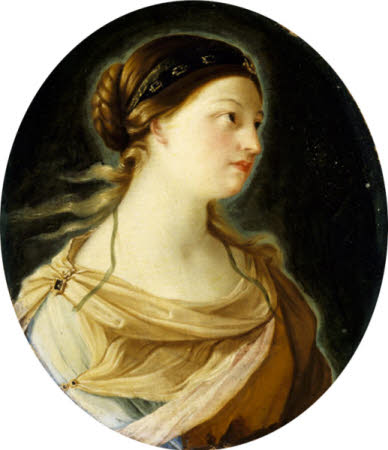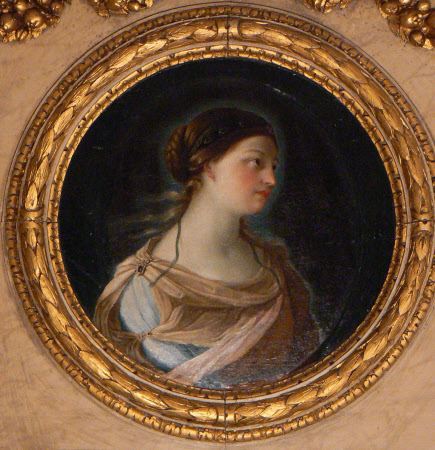Head of Helen of Troy
after Guido Reni (Bologna 1575 – Bologna 1642)
Category
Art / Oil paintings
Date
1630 - 1683
Materials
Oil on canvas (circular)
Measurements
640 mm (Dia)
Place of origin
Italy
Order this imageCollection
Ham House, Surrey
NT 1140146
Summary
Oil painting on canvas (circular), Head of Helen of Troy, after Guido Reni (Bologna 1575 – Bologna 1642). A circular half-length portrait of a young woman, turned to the right, almost profile, dark brown hair, wearing a white linen shift beneath a gold cloak. Helen was the daughter of Zeus and Leda; the wife of Menelaus, king of Sparta, and subsequently of Paris, son of King Priam of Troy. Her sister Clytemnestra married Agamemnon, who was the brother of Menelaus. Her brothers were Castor and Polydeuces (Pollux), the Dioscuri. Helen and Menelaus's daughter Hermione married Orestes. This is an example of a much copied part of Guido Reni's The Abduction of Helen in the Louvre, painted in Rome between 1627-31 for Philip IV of Spain, bought by Queen Marie de Medici of France whose exile resulted in its being acquired by Louise Phélypiaux de La Vrillière as one of the first of the large pictures to adorn the gallery of his hôtel in Paris, whence it was removed to the Louvre at the time of the French Revolution. Another copy of the whole scene painted by Giacinto Campana and retouched by Reni himself is in the Galleria Spada, Rome.
Provenance
In 1679-1683 Mr Wyck's Ham House catalogue first as by an Italian hand and then as Guido; by thence by descent until acquired in 1948 by HM Government when Sir Lyonel, 4th Bt (1854 – 1952) and Sir Cecil Tollemache, 5th Bt (1886 – 1969) presented Ham House to the National Trust, and entrusted to the care of the Victoria & Albert Museum, until 1990, when returned to the care of the National Trust, and to which ownership was transferred in 2002
Makers and roles
after Guido Reni (Bologna 1575 – Bologna 1642), artist
References
Pepper 1984 D. Stephen Pepper, Guido Reni: A Complete Catalogue of his Works with an Introductory Text, Oxford 1984, p.264, plate 159, no.132.

